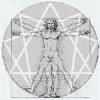“It is impossible to study a system of the universe without studying man. At the same time it is impossible to study man without studying the universe. Man is an image of the world. He was created by the same laws which created the whole of the world. By knowing and understanding himself he will know and understand the whole world, all the laws that create and govern the world. And at the same time by studying the world and the laws that govern the world he will learn and understand the laws that govern him. In this connection some laws are understood and assimilated more easily by studying the OBJECTIVE WORLD, while man can only understand other laws by studying himself. The study of the world and the study of man must therefore run parallel, one helping the other. Fragments: Four
“But at the beginning it is enough to understand the general principle: every phenomenon, of whatever magnitude it may be, is inevitably the manifestation of three forces; one or two forces cannot produce a phenomenon, and if we observe a stoppage in anything, or an endless hesitation at the same place, we can say that, at the given place, the third force is lacking. In trying to understand this it must be remembered at the same time that people cannot observe phenomena as manifestations of three forces because we cannot observe the OBJECTIVE WORLD in our subjective states of consciousness. And in the subjectively observed phenomenal world we see in phenomena only the manifestation of one or two forces. If we could see the manifestation of three forces in every action, we should then see the world as it is (things in themselves). Only it must here be remembered that a phenomenon which appears to be simple may actually be very complicated, that is, it may be a very complex combination of trinities. But we know that we cannot observe the world as it is and this should help us to understand why we cannot see the third force. The third force is a property of the real world. The subjective or phenomenal world of our observation is only relatively real, at any rate it is not complete. Fragments: Four

